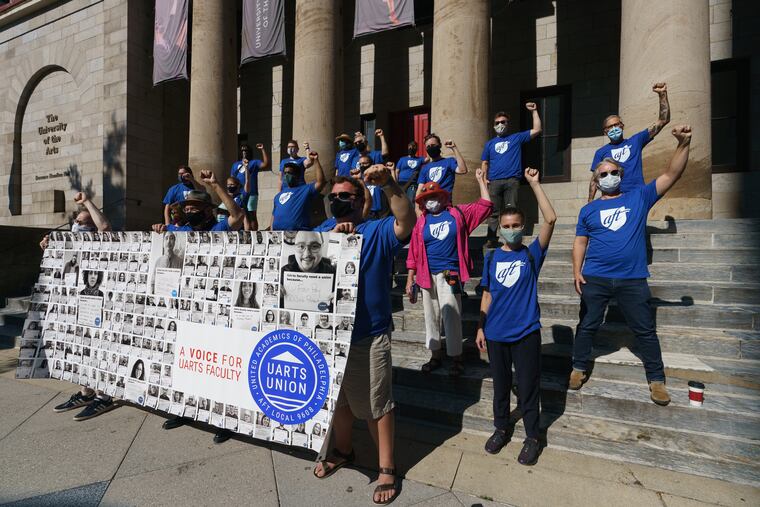Most UArts professors are adjuncts. Now, they want to unionize.
The faculty at UArts join a movement of thousands of contingent higher education instructors across the country who have turned to unions to fight for job security and better pay.

Professors at University of the Arts, most of whom are adjuncts with no job security, announced on Labor Day that they want to unionize with United Academics of Philadelphia.
A majority of the more than 500 eligible faculty members have signed union cards, said Daniel Piezckolon, an adjunct professor and president of UAP, a union formed in 2014 to focus on what Piezckolon called the “adjunctification of higher education.”
UArts faculty, who held a rally Monday morning outside the school’s Hamilton Hall on South Broad Street, are asking the administration to voluntarily recognize their union. UArts did not immediately respond to a request for comment.
The faculty at UArts join a movement of thousands of contingent higher-education instructors across the country who have turned to unions to fight for job security, better pay, and a voice in university decisions. In the Philadelphia area, the nearly 200 adjunct professors at Arcadia University, including Piezckolon, joined UAP in 2017. At Temple, 1,400 adjuncts joined the university’s staff union in 2015.
The movement comes as higher education increasingly relies on contingent labor, including adjuncts, non-tenure-track faculty, and graduate students. In 2018, they made up nearly three-quarters of teaching staff in higher education in the United States, according to federal data. Part-time teachers made up 40% of that workforce, up from 24% in 1975. In the fall of 2018 at UArts, that number was even higher: 76% of instructors were adjuncts, according to the National Center for Education Statistics.
These are the gig workers of higher ed, those who cobble together multiple teaching jobs at different universities to make ends meet, all while waiting to see if they’ll get their contract renewed each semester and struggling to get access to affordable health care through their jobs. Many have debt from their higher degrees.
Imani Roach got hired at UArts in 2016 after Black students successfully campaigned for an African art class. The following year, Roach, a Harvard University doctoral candidate in African and African American studies, found out right before the semester began that the class had been canceled and had to scramble to find a job.
She came back in 2018 and has been teaching two to three classes at the school per semester ever since. She’s also taught at Moore, PAFA, Temple, Penn — pretty much all of the schools in the area, she said. This semester, she’ll be teaching five courses across several schools, almost twice the normal course load. In her experience, the pay at schools with unions, such as Temple, or those with resources, such as Penn, is often more than double what adjuncts get paid at other schools, sometimes triple.
Roach, 37, said she’s invested in UArts, as she’s an artist herself and it’s the school that gave Roach her first shot. But she doesn’t feel as if she can really put her all into the school — mentor students, get involved with student-led efforts to combat anti-blackness at the university — if she has no job security and is teaching at three other schools.
“It’s really important to support [the students] and the changes they want to see,” she said. “It’s important to develop long-standing relationships with them. I think it doesn’t serve them to have people who are in and out, to have people who are overworked teaching their classes.”
Matt Curtius, an illustration professor and one of the few full-time faculty members, said he was concerned that the union drive would send the message to students that their teachers don’t care about them. (That teachers who want to unionize are out for their own interests at the expense of students is a commonly used talking point by opponents of faculty unions and one that teachers have sought to correct.)
It’s the opposite, he said.
“We’re doing this because we care about them,” said Curtius, 46. “We think this is the best way to give them the best education.”